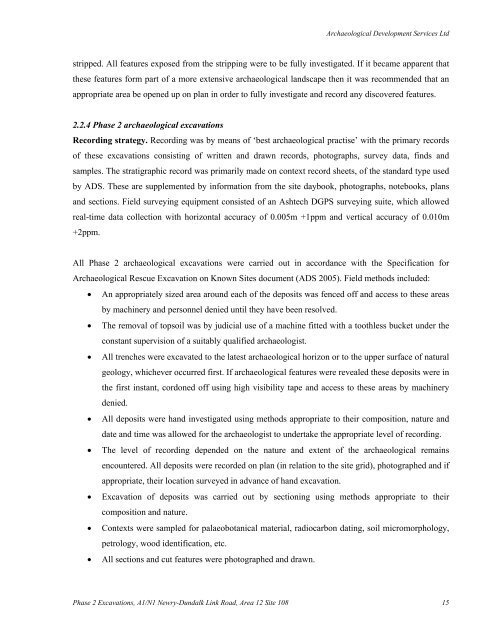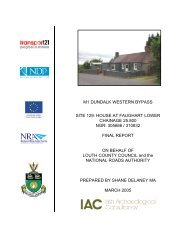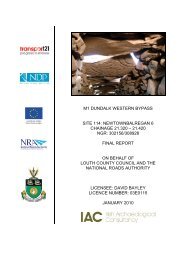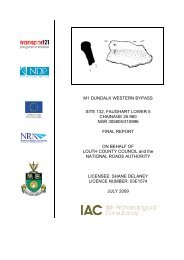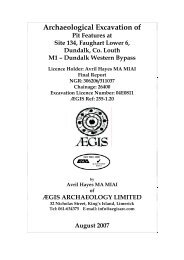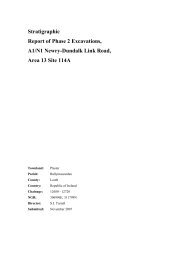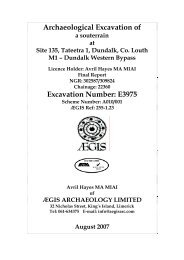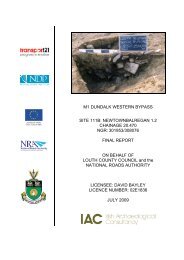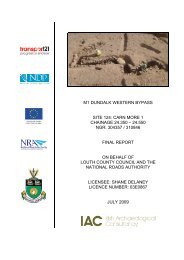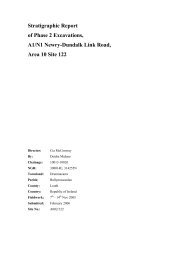Aghnaskeagh 1 Interim Report - ASI Louth
Aghnaskeagh 1 Interim Report - ASI Louth
Aghnaskeagh 1 Interim Report - ASI Louth
You also want an ePaper? Increase the reach of your titles
YUMPU automatically turns print PDFs into web optimized ePapers that Google loves.
Archaeological Development Services Ltd<br />
stripped. All features exposed from the stripping were to be fully investigated. If it became apparent that<br />
these features form part of a more extensive archaeological landscape then it was recommended that an<br />
appropriate area be opened up on plan in order to fully investigate and record any discovered features.<br />
2.2.4 Phase 2 archaeological excavations<br />
Recording strategy. Recording was by means of ‘best archaeological practise’ with the primary records<br />
of these excavations consisting of written and drawn records, photographs, survey data, finds and<br />
samples. The stratigraphic record was primarily made on context record sheets, of the standard type used<br />
by ADS. These are supplemented by information from the site daybook, photographs, notebooks, plans<br />
and sections. Field surveying equipment consisted of an Ashtech DGPS surveying suite, which allowed<br />
real-time data collection with horizontal accuracy of 0.005m +1ppm and vertical accuracy of 0.010m<br />
+2ppm.<br />
All Phase 2 archaeological excavations were carried out in accordance with the Specification for<br />
Archaeological Rescue Excavation on Known Sites document (ADS 2005). Field methods included:<br />
• An appropriately sized area around each of the deposits was fenced off and access to these areas<br />
by machinery and personnel denied until they have been resolved.<br />
• The removal of topsoil was by judicial use of a machine fitted with a toothless bucket under the<br />
constant supervision of a suitably qualified archaeologist.<br />
• All trenches were excavated to the latest archaeological horizon or to the upper surface of natural<br />
geology, whichever occurred first. If archaeological features were revealed these deposits were in<br />
the first instant, cordoned off using high visibility tape and access to these areas by machinery<br />
denied.<br />
• All deposits were hand investigated using methods appropriate to their composition, nature and<br />
date and time was allowed for the archaeologist to undertake the appropriate level of recording.<br />
• The level of recording depended on the nature and extent of the archaeological remains<br />
encountered. All deposits were recorded on plan (in relation to the site grid), photographed and if<br />
appropriate, their location surveyed in advance of hand excavation.<br />
• Excavation of deposits was carried out by sectioning using methods appropriate to their<br />
composition and nature.<br />
• Contexts were sampled for palaeobotanical material, radiocarbon dating, soil micromorphology,<br />
petrology, wood identification, etc.<br />
• All sections and cut features were photographed and drawn.<br />
Phase 2 Excavations, A1/N1 Newry-Dundalk Link Road, Area 12 Site 108 15


